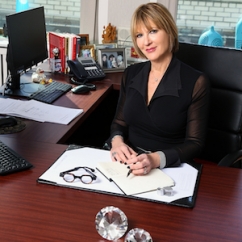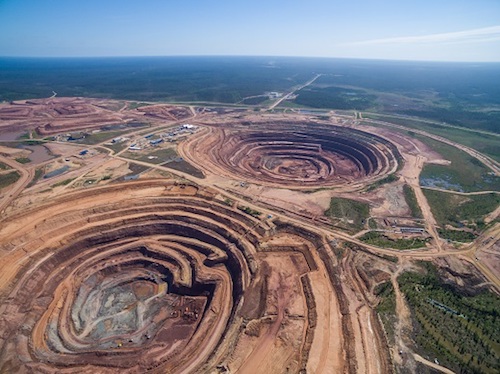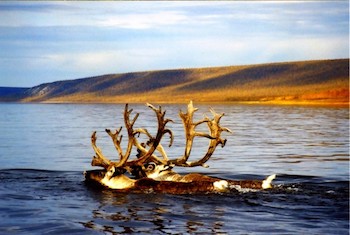Articles and News
Exclusive! ALROSA’s New U.S. President Talks About Stories, Supply, and Synthetics | February 19, 2019 (0 comments)

New York, NY—Now that Russian diamond mining giant ALROSA has resumed full-scale operations in the American market, retailers and manufacturers alike can expect to benefit from significantly amped-up diamond marketing efforts. Although it has had an office here since 2006, ALROSA was not engaged in the market since 2016. Now it’s ready to be back in the world’s largest diamond market in a big way.
Related: Rebecca Foerster To Head ALROSA USA
In an exclusive first interview with The Centurion Newsletter, Rebecca Foerster, left, ALROSA’s new U.S. president, details the company’s plans and shares her perspective as an experienced marketing executive. (Image: David Stewart Brown)
The Centurion Newsletter: What are your key goals for ALROSA US?
Rebecca Foerster: To make sure that every part of the supply chain is aware of our presence in the United States, and that the office will be very active and engaged with all different types of initiatives.
The Centurion: Name some?
Foerster: Marketing initiatives specific to the U.S. market with manufacturers and retailers, press outreach, and conducting four rough tenders and two polished tenders in 2019. It’s my goal to make sure that all qualified dealers and manufacturers are aware of these tenders so we can invite them to register and become approved to participate in these special events.
It’s also very important to outreach to the press to make sure they’re aware of what we’re doing to add value to natural mined diamonds, as well as taking an active role in doing everything we can to protect and stimulate demand for mined diamonds now that there’s a lot of buzz and discussion around lab-grown stones.
The Centurion: What is ALROSA’s predominant output?
Foerster: ALROSA has been the world’s largest diamond mining company by volume since 2009, and its market share is about 27%. Every fourth diamond in the global market came from Yakutia, Russia.
We provide all range of goods from smalls to large unique stones. A few weeks ago we found a 192-carat diamond in the Yakutian Udachny deposit. We also produce at least 7,000 carats of colored rough annually and operate our own in-house cutting and polishing division, which concentrates on large unique white and fancy colored diamonds. Our aim is to become the world’s largest producer of colored polished diamonds as well as unique white diamonds. In 2019, the company plans to increase diamond production to almost 38 million carats from 36.7 million carats in 2018.

ALROSA's Lomonosov mine in the Arkhangelsk region of Russia.
The Centurion: What will be offered at the tenders?
Foerster: Last year, ALROSA held two auctions for special size rough (over 10.8 carats) and one polished diamond tender here in New York. These are very different from what is part of our regular sightholders’ allocation boxes. Very often in our rough tenders, we have opportunities to put out very large rough, like 50+ carats, gem-quality white G colors and up. Last year’s results showed a high demand for ALROSA rough, and gave us reason to schedule four rough auctions for 2019 and significantly increase selling our own polished diamonds.
The Centurion: Will you be launching any retailer initiatives, or will your focus be at the manufacturer end?
Foerster: Two large U.S. retailers—Tiffany and Signet—are among our long-term clients for rough diamonds already, along with large Chinese retailers Chow Tai Fook and Chow Sang Sang.
Our goal is to be inclusive, and involve as many of our long-term customers and sightholders in mine-to-counter initiatives with retail partners as we can. Those will range from high-end luxury—and extremely high-end unique opportunities—to doing something on a larger scale to get our product out to more consumers.
The Centurion: What retailer support will be available?
Foerster: My goal is to try and structure it as turnkey as possible. There will be retailer toolkits, marketing efforts they can tap into, brand guidelines and look books, and we will be working with designers to create specific design collections for retailers, using ALROSA goods tested to have resonance with consumers, and that have the credibility of having been designed by reputable influential designers. We are in process of negotiating that, but once we do have that worked out the selection will be well received.
The Centurion: How will you address designers’ territory exclusivity?
Foerster: It’s a bit of a puzzle, and we need to work out details, but our objective is to work with designers who have as much broad reach among our target retailer customers as possible to meet the distribution channel we want to meet. Everything is about looking at the complete supply chain and making sure everyone can add benefit and value to the diamonds.
The Centurion: There’s so much discussion about Millennials, diamonds, and jewelry. What are your thoughts?
Foerster: Everything today is about a story. Your product, whatever it is, is a manifestation of that story. As a pure-play mined diamond person, my belief is that it is our duty to tell the stories that increase their inherent value. If we do that as a coordinated industry and do it well, I think that the demand for diamonds among Millennials and the next group, Gen-Z, will continue to be healthy. But it’s on us to make sure.
Fine jewelry is an age-old story, but we have for some reason not marketed it or promoted it to women as a self-purchase. They are interested in it as an experience and there’s no reason we can’t provide that experience, whether they’re interested in the [diamond] journey and give-back, or the retail experience.
The Centurion: Let’s talk more about women and diamonds.
Foerster: Luxury goods such as bags have become equated with status and aspiration, and a ‘you’ve arrived’ sort of thing. It’s probably taken some of our market share. But I think if you’re able to buy a diamond with a clear story of origin and a clear story about its journey, it doesn’t necessarily have to have visible branding. Today’s consumer is looking at product and where they spend their money a little bit differently, and if you can talk about [the journey] and explain that to your peers and friends, we have a good chance of competing against other luxury products.
It doesn’t have to be that the logo is on the diamond or on the ring, but if you have a certificate or a storybook or you can go online and show your friends the whole journey of the diamond and how it gives back to people around the world, that’s as aspirational and exciting as anything. It almost gives you justification for making that purchase—which a lot of those consumers are looking for.
The Centurion: Lab-grown has lots of folks worried. Should they be?
Foerster: Lab-grown is here to stay, and it’s totally normal and healthy to have competition in any category. I think there will always be a desire for mined diamonds, but we have to keep pushing that message. I think ALROSA is perfectly positioned because of its ability to claim mine-of-origin, and because of the amazing sustainability and give-back stories for all the communities that thrive and exist around our mines.
But we should not be lazy or assume that consumers understand the difference between natural mined and lab-grown diamonds. There’s more to it than saying the physical properties of the final output are the same: the journey and inherent value and story behind that same molecular composition are completely different.
We need to be more aggressive in our voice to make sure [consumers] understand how a diamond comes out of the ground, all the hands that touch it to make sure it becomes a polished diamond in a piece of jewelry, and what it means for the livelihood and give-back component in all the diamond communities around the world.

Protecting the migratory routes of wild reindeer is one of ALROSA's environmental initiatives.
The Centurion: What is your best advice for a high-end independent retailer for the future?
Foerster: It’s about understanding the online experience, proper use of social media, and making the whole purchase an experience. It’s about talking to customers in a tone of voice that’s selling the values of their brand as a company, and what they stand for and believe in, rather than just selling product.
Everything is cyclical. Remember there was a point where people didn’t trust mom-and-pop independent jewelers anymore? Now there’s a shift back. Retailers that connect to the consumer based on sharing their values as a company—including being responsible, having a concern about sourcing, and giving back to the community—those are the guys are going to do very well. More and more consumers looking for that intimate experience relating to a retailer that way.
Bring in younger people who understand that tone of voice and the social media tools and platforms. You’re going to have to embrace some things that you’ve never done before, or are not 100% comfortable with, but you can find talent to help you do that.
The online platform is so key, because that’s the way people shop. They’ll first go online and research something so if they don’t connect with how you look or what you’re saying, there’s probably a great chance they won’t go any further.
The Centurion: What are ALROSA’s initiatives in ethical and responsible sourcing?
Foerster: Millennials’ perception of diamonds is different from what their parents had, but all modern consumers think about ethical issues of mining: where this stone was mined, how it was formed, how it was cut and polished, and who manufactured it. They would like to know whether this diamond is from conflict areas, whether ethical standards were violated during its mining, what are the working conditions of employees, are there social programs around it, and whether the environment was polluted. As I said earlier, ALROSA is well-positioned with the ability to claim mine-of-origin on its stones.
Related: D.E.F. To Honor Luxury Jewelers And ALROSA
According to a PwC study, ALROSA is the industry leader in social investment, annually allocating about 3% of revenue and spending more than 10 billion rubles on social and charity initiatives for more than 500 projects. And going forward, with the development of blockchain and tracing, we’ll be able to see right down to a diamond’s date of extraction and the name of the employee who extracted it from the ore.







